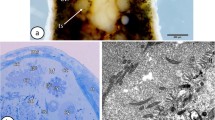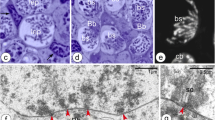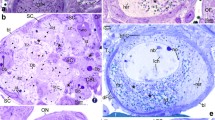Abstract
A study of male meiosis has been carried out on air-dried testicular preparations from 10 adult Djungarian hamsters (Phodopus sungorus campbelli Th.). The general course of meiosis in this species seems to be similar to that in most of the mammals so far studied. A short description of the main meiotic stages from pachytene to metaphase II has been presented. The sex-chromosomes (X and Y) show end-to-end pairing and prereduction. Between pachytene and diplotene there probably exists a diffuse stage. The large size of nuclei, the presence of double, occasionally crossed thin chromatin threads with a small number of double chromatin knobs are typical for this stage. The sex-vesicle is still present here but it is not so distinct as at pachytene, probably due to the beginning of straightening of the sex-bivalent. The differential arm of the X chromosome shows allocycly. During diplotene-diakinesis this arm looks like a thin double thread which is several times longer than the pairing arm. At metaphase I the differential arm is more condensed but usually the X does not become metacentric as at metaphase of mitosis. The allocycly of the X has been observed already at pachytene. The light zone of the sex-vesicle is formed by a smooth coiled thread or band which in some of the nuclei looks like a loop or “tail” protruding from the dark zone. A possible relationship between the allocycly of the X chromosome arm and its active functional state during meiotic prophase is suggested.
Similar content being viewed by others
References
Barry, E. G.: The diffuse diplotene stage of meiotio prophase in Neurospora. Chromosoma (Berl.) 26, 119–129 (1969).
Beaumont, H. A.: Radiosensitivity of primordial oocytes in the rat and monkey. In: Effects of radiation on meiotic systems, p. 71–79 Vienna: IAEA 1968.
—, Mandl, A. M.: A quantitative and cytological study of oogonia and oocytes in the foetal and neonatal rat. Proc. roy. Soc. Lond. B 155, 552–579 (1962).
Callan, H. C.: The nature of lampbruoh chromosomes. Int. Rev. Cytol. 15, 1–34 (1963).
Effects of radiation on meiotic systems. Vienna: IAEA 1968.
Emmons, L. R., Husted, L.: The sex bivalent of the Golden hamster. J. Hered. 53, 227–232 (1962).
Evans, E. P., Breckon, G., Ford, C. E.: An air drying method for meiotic preparations from mammalian testes. Cytogenetics 3, 289–294 (1964).
Ford, E. H. R., Woollam, D. H. M.: The fine structure of the sex vesicle and sexchromosome association in spermatocytes of mouse, golden hamster and field vole. J. Anat. (Lond.) 100, 787–799 (1966).
Fraccaro, M., Gustavsson, I., Hultén, M., Lindsten, J., Tiepolo, L.: Late-replicating Y chromosome in spermatogonia of the Chinese hamster (Cricetulus griseus). Cytogenetics 8, 263–271 (1969).
Fredga, K.: Idiogram and trisomy of the water vole (Arvicola terrestris L.), a favourable animal for cytogenetic research. Chromosoma (Berl.) 25, 75–89 (1968).
—, Santesson, K. B.: Male meiosis in Syrian, Chinese, and European hamsters. Hereditas (Lund) 52, 36–48 (1964).
John, B., Lewis, K. R.: The meiotic system. Protoplasmatologia VI/F/1. Wien-New York: Springer 1965.
Koller, P. C.: The genetical and mechanical properties of the sex-chromosomes. IV. The golden hamster. J. Genet. 36, 177–195 (1938).
Lima-de-Faria, A., Jaworska, H.: Late DNA synthesis in heterochromatin. Nature (Lond.) 127, 138–142 (1968).
Matthey, R.: Analyse cytotaxonomique de huit espèces de Muridae, Murinae, Cricetinae, Microtinae paléaectiques et nord-américains. Arch. Klaus-Stift. Vererb.-Forsch. 32, 385–404 (1957).
—: Cytologie comparée des Cricetinae paléarctiques et américains. Rev. suisse Zool. 68, 41–61 (1961).
—: La formule chromosomique chez sept espèces et sous-espèces de Murinae africains. Mammalia (Paris) 27, 157–176 (1963).
Meyer, M. N.: Peculiarities of the reproduction and development of Phodopus sungorus Pallas of different geographical populations. Zool. J. (USSR) 46, 604–613 (1967).
Moens, P. B.: A new interpretation of meiotio propliase in Lycopersicon esculentum (tomato). Chromosoma (Berl.) 15, 231–242 (1964).
—: The structure and function of the synaptinemal complex in Lilium longiflorum sporocytes. Chromosoma (Berl.) 23, 418–451 (1968).
Mukherjee, B. B., Ghosal, S. K.: Replioative differentiation of mammalian sex-chromosomes during spermatogenesis. Exp. Cell Res. 54, 101–106 (1969).
Peacock, W. J.: Replication, recombination and chiasmata in Goniaea australasiae, (Orthoptera: Acrididae). (1968) (Cit. from Barry, 1969).
Pogosianz, H. E., Brujako, T.: Somatic chromosomes of Djungarian hamster (Phodopus sungorus). Genetics (USSR) 3, 2–20 (1967).
—: Polyploid cells in mamalian meiosis. Genetics (USSR), 5, 176–178 (1969).
— Sokova, O.I.: Maintaining and breeding of the Djungarian hamster under laboratory conditions. Z. Versuchstierk. 9, 292–297 (1967).
- - Yanovich, L. I.: The normal karyotype of the Djungarian hamster. Cytologia (USSR) (in press) 1970.
Sasaki, M., Makino, M.: The meiotic chromosomes of man. Chromosoma (Berl.) 16, 637–651 (1965).
Sen, S. K.: Chromatin-organization during and after synapsis in cultured microsporocytes of Lilium in presence of mitomycin C and cyclohexinide. Exp. Cell Res. 55, 123–127 (1969).
Sheaffer, C. I.: The X-bivalent of the golden hamster. Virginia J. Sci. 6, 46–52 (1955).
Utakoji, T.: On the homology between the X and the Y chromosomes of the Chinese hamster. Chromosoma (Berl.) 18, 449 (1966).
—, Hsu, T. S.: DNA replication patterns in somatic and germline cells of the male Chinese hamster. Cytogenetics 4, 295–305 (1965).
Vorontsov, N. N., Radzabli, S. L., Liapunova, K. L.: Caryological differentation of allopatric forms of hamsters species Phodopus sungorus and heteromorphism of sex-chromosomes in females. Dokl. Acad. Sci. USSR (Ser. B) 172, 703–705 (1967).
White, M. J. D.: The chromosomes, 5th ed. London: Methuen 1961.
Wilson, E. B.: The cell in development and heredity, 3rd ed. New York: Macmillan 1925.
Zakharov, A. F.: Heterochromatin and genetic inactivation in mammalian cells. Usp. sovrem. Biol. (USSR) 65, 83–106 (1968).
Author information
Authors and Affiliations
Rights and permissions
About this article
Cite this article
Pogosianz, H.E. Meiosis in the Djungarian hamster. Chromosoma 31, 392–403 (1970). https://doi.org/10.1007/BF00285831
Received:
Accepted:
Issue Date:
DOI: https://doi.org/10.1007/BF00285831




